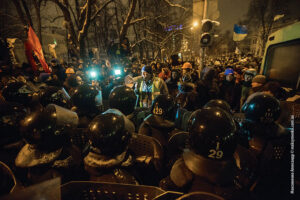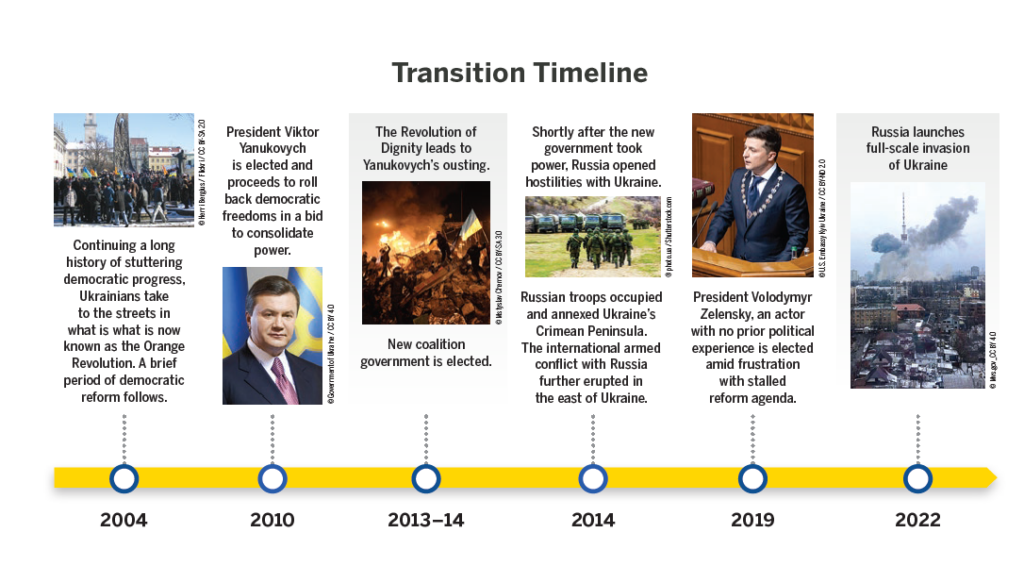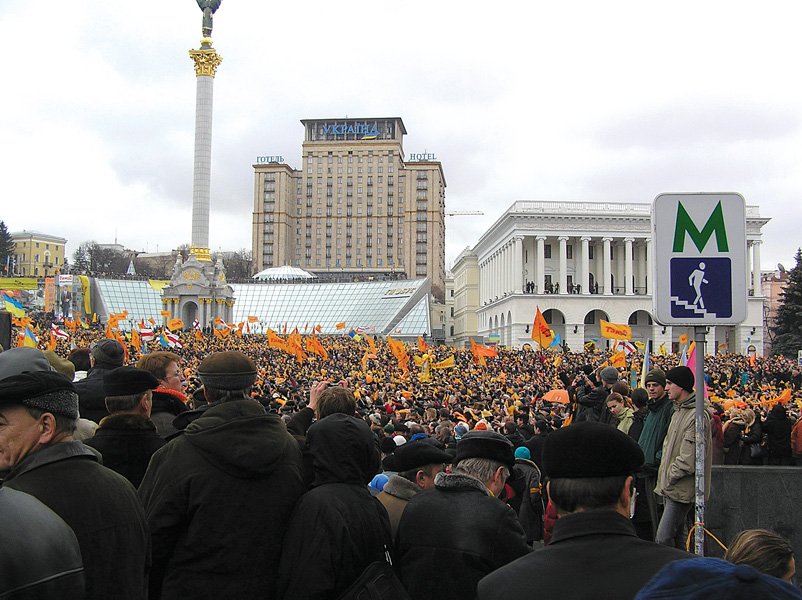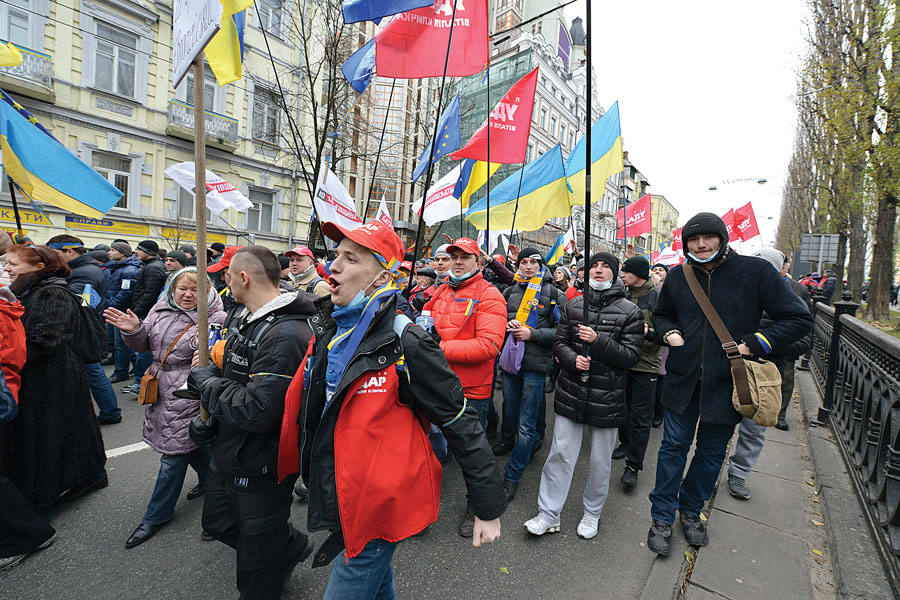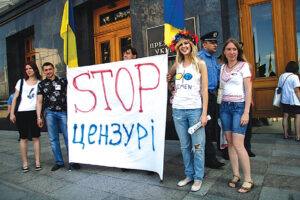Introduction
Since gaining independence after the dissolution of the Soviet Union in 1991, Ukraine has lurched along an unsteady path toward accountable democratic governance. Yet despite the country’s volatile politics and the escalating conflict with Russia leading up to the full‑scale invasion of Ukraine in February 2022, Ukrainian reformers and their allies have made significant progress in reshaping the country’s media climate.
Ukraine’s media reform successes, most of which materialized between 2014 and 2019, are the result of a decade of effort from local media reform groups after the Orange Revolution in 2005. They include the privatization of previously state-owned print media and an enhanced law governing transparency of media ownership, among others. The country is home to numerous independent media outlets that serve the public interest and hold the government to account. Further, the sector has active civil society organizations, which support independent journalism through advocacy and self-regulation. Ukraine’s public service broadcaster has gone through a series of reforms that has left it professionally managed and largely free of state influence.
Ukrainian civil society, journalists, and human rights defenders were on the front lines of efforts to build an independent and pluralistic media system, advancing a reform vision when political winds were favorable. Pan-European organizations, especially the Council of Europe, also played an important role in defining and guiding Ukraine’s reform agenda. International donors and media assistance organizations also share credit for their sustained engagement in the country during the post-Soviet period, helping to mobilize a robust civil society able to effect significant change when a political opening occurred in 2014.
Despite its strength and diversity, Ukraine’s media environment has its fair share of challenges. Even before Russia’s full-scale invasion in 2022, the country was—and remains—a target of Russian disinformation and hate speech. As a result, Ukraine’s government restricts access to Russian broadcast channels, online media, and social media websites. The country’s judiciary and law enforcement have struggled to effectively investigate attacks on journalists. And a small group of powerful oligarchs control the country’s major private TV channels that dominate the media marketplace.1
However, media reform in Ukraine has progressed significantly. Ukrainian civil society organizations were instrumental in pushing for reform even when the country’s democratic transition faltered. Their efforts highlight the importance of supporting the creation of a strong civil society sector capable of coordinating, mobilizing, and sustaining momentum for a media reform vision.
Ukraine’s experience demonstrates the importance of long-term support for media reform, even in instances of temporary, semi-authoritarian backsliding. The country’s path to democracy was not a straight line—each wave of democratic progress brought with it important legal reforms for the media sector, even if those victories were followed by long periods of stagnation. This report, part of the Center for International Media Assistance’s “Media Reform amid Political Upheaval” series, highlights the ways that media support to Ukraine has been exemplary. Donor support for a broad-based, bottom-up media sector reform effort was essential to the progress made in the years following the 2014 Euromaidan protests. That reform coalition, however, will need to adapt to new post-war realities. Based on interviews with 18 Ukrainian media experts conducted during the first months of 2021, this briefing points to how media assistance actors and foreign donors might improve the climate for independent journalism in Ukraine in the future.
Background: Independence to the Orange Revolution
Following independence in 1991, the government privatized many state-owned news organizations, allowing foreign and Ukrainian entrepreneurs to establish new outlets. Through the 1990s and early 2000s a small group of wealthy business owners purchased or established a number of the most prominent and successful media outlets, consolidating control over the media sector.2 Outlets owned by these oligarchs soon surpassed the state broadcaster in quality and reach, leaving the oligarchs with a dominant position in the media sector.
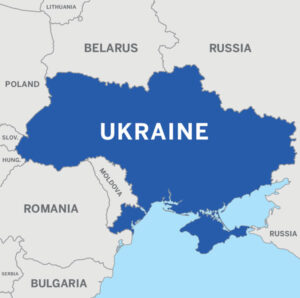 Civil society made limited progress in advancing reforms during this period. Policy achievements included the establishment of a national broadcasting regulator in 1994 and the decriminalization of defamation in 2001. Perhaps most vitally during this era, international assistance actors invested heavily in local capacity development and trained a cohort of media law specialists, some of whom went on to establish civil society organizations supporting media. These groups would have significant impact in the years to come.
Civil society made limited progress in advancing reforms during this period. Policy achievements included the establishment of a national broadcasting regulator in 1994 and the decriminalization of defamation in 2001. Perhaps most vitally during this era, international assistance actors invested heavily in local capacity development and trained a cohort of media law specialists, some of whom went on to establish civil society organizations supporting media. These groups would have significant impact in the years to come.
But these early reforms were mainly advanced by isolated groups of activists and journalists rather than by broad social movements. In 1999, the Council of Europe outlined a comprehensive framework for Ukrainian media reform—a plan that was expanded two years later in reaction to the killing of journalist Georgiy Gongadze, an outspoken critic of then-President Leonid Kuchma, in 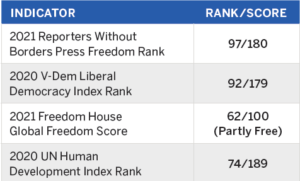 2000.
2000.
Gongadze’s murder inspired journalists to push for reforms as presidential elections in 2004 loomed between Kuchma’s chosen successor, pro-Russian Prime Minister Viktor Yanukovych, and pro-European reformist Viktor Yushchenko. They focused particularly on combatting censorship by media owners as well as temnyky—secret directives to national broadcasters and print outlets formulated by Kuchma’s regime.
This “journalists’ revolution” was a direct predecessor of the 2004 Orange Revolution, when tens of thousands of people took to the streets to protest initial election results that showed Yanukovych winning the presidential poll amid reports of fraud and intimidation. After Yushchenko won a court-ordered repeat of the presidential poll and took power in 2005, reformists were hopeful of rapid progress.
Hope Stagnates: 2005–13
Under Yushchenko, Ukrainian reformers along with international media assistance organizations sought to advance a new agenda. They focused initially on reforming the state broadcaster, which was widely seen as a propaganda tool under Kuchma. Several new civil society organizations with media sector expertise, including the Media Law Institute, the Institute of Mass Information, and the Regional Press Development Institute, were engaged in all phases of policy development and advocacy.
However, despite the adoption of landmark access-to-information legislation in 2011, their efforts were largely fruitless in the period from 2005 to 2014, which became known as the “stagnation” period. The Ukrainian public was not actively engaged in media issues as corruption and the judiciary’s lack of independence overshadowed other governance concerns, while pro-reform politicians were often consumed with infighting. Meanwhile, a number of interests worked to thwart change. Oligarchs took advantage of the underdeveloped regulatory environment to consolidate their control of Ukraine’s largest media outlets during this period. Local print media benefitted from state funding and reciprocated by serving as propaganda tools for local authorities, while members of parliament enabled the status quo for the benefit of their oligarch backers.
Ironically, the only successful reform during the stagnation era came after Yanukovych took power following presidential elections in 2010. In response to his regime’s increasing attempts to shrink space for independent media and civil society, 200 media representatives and activists collaborated to found the “Stop the Censorship!” movement.
This coalition focused on alleviating pressure on journalists and advocating for a new law supporting access to public information. They consciously chose not to accept direct funding from international entities, though many of the group’s members worked in organizations supported by foreign donors. Along with a cooperative effort by media outlets in raising public awareness, in 2011 the group succeeded in persuading parliament to adopt a new law on access to public information.
At that point, Yanukovych’s party was generally indifferent to liberal reforms, and experts indicated that the administration saw no threat from this law and viewed it as useful for demonstrating positive change to its European partners as part of its attempt to secure a broader political and economic association agreement with the European Union (EU).
Euromaidan and Reform’s Rebirth
Yanukovych’s decision to reject signing the association agreement with the EU in late 2013 and instead seek closer ties with the Russian Federation sparked the massive street protests known as Euromaidan. The protest movement and Yanukovych’s violent attempt to repress it eventually led parliament to oust him in early 2014, setting off a tumultuous year in Ukrainian history. After Yanukovych fled to Russia and Russian troops occupied and annexed Ukraine’s Crimean Peninsula, the international armed conflict with Russia further erupted in the east.
As Ukrainian troops battled Russia in the east, reformers pushed ahead in the capital. The timing was fortuitous. The momentum for change sparked by the protests combined with weakened state resources gave local civil society groups unprecedented policymaking influence. Organizations in fields as diverse as media, the environment, and economics united under the umbrella of a broad coalition called the Reanimation Package of Reforms (RPR). The goal: unite behind a broad roadmap of reforms in nearly all sectors to “reanimate” the country and prepare for integration with the European Union.
At its peak, the RPR comprised more than 80 civil society groups, making it the most significant cross-sectoral reform coalition in Ukraine’s modern history. Between 2014 and 2019, Ukraine’s parliament adopted more than 80 laws proposed by RPR members. Among these were media laws that were drafted with substantial input from civil society, including laws on media ownership transparency as well as reforming the public service broadcaster and state-financed print media. Nor was the influence of civil society limited to drafting and advocating reforms from the outside: A number of members from Ukrainian media civil society groups were elected to parliament or took jobs in government in 2014—further influencing the reform agenda.
In short, the RPR did groundbreaking work in the media reform movement in Ukraine. Given the right circumstances and timing, the coalition provided policy development and advocacy that helped consolidate the state in the aftermath of a popular revolution and Russian aggression. As the Ukrainian government gradually regained capacity, local stakeholders shifted focus from reform to implementation of existing laws and the activity of the RPR diminished.
Role of International Donors and Media Assistance Actors
Ukraine has long received media assistance from international sources, and more than a dozen donors and implementing agencies invested in reform during the RPR period, covering issues ranging from journalism development to policy reform. Foreign donors provided almost $150 million to support the development of Ukraine’s media sector between 2010 and 2019.3 The most influential donors include the Swedish International Development Cooperation Agency, the US Agency for International Development, the Council of Europe, and the Danish International Development Agency. A number of other European donors also play important roles. The larger actors have tackled demanding and sensitive issues, including public service broadcaster reform, promotion of media pluralism in the region, privatization of state print media, and transparency of media ownership.
Many major donors also directly supported the RPR coalition’s activities between 2015 and 2019. This was the first time donors had made a significant investment in a coalition, as prior groups such as “Stop the Censorship!” were more ad hoc in approach. RPR funding covered communications and advocacy events, including international trips, press breakfasts for diplomats, large-scale public forums, and the research and legal drafting work of RPR’s expert groups. Donors also often had long-running partnerships with key members of the RPR coalition, including the Civil Society Institute, the Centre of United Actions, and the Centre for Democracy and Rule of Law (formerly known as the Media Law Institute).
The members of the RPR coalition set their own priorities for reform and created an implementation plan. However, through public events its work was open to external engagement and comments from donors, government officials, international experts, and other stakeholders. Importantly, the donor community began financially supporting the coalition only after it had achieved initial success and embraced the RPR agenda without interfering in the coalition’s plans.
Future Opportunities and Recommendations
The Ukrainian media sector is facing incredible uncertainty in the wake of the 2022 Russian invasion. At the same time, the prospect of EU candidacy status, which is conditional inter alia upon the implementation of the EU Audiovisual Media Services Directive in Ukraine,4 has created another opportunity for the adoption of the long-overdue Draft Law on Media.5
Donors and media assistance organizations have a critical role to play in shoring up the sector to prepare for this and future windows of opportunity. This should include support for advancing and implementing the proposed new media law, which would align Ukraine’s regulations with the European Union’s Audiovisual Media Services Directive. The directive covers issues such as combatting racial and religious hatred, protecting minors, providing access to media for people with disabilities, and promoting and distributing European media.
A longer-term goal should be to ensure transparency in media financing and media ownership through antitrust mechanisms that would counteract media capture by oligarchs and defend against Russian-backed information operations. Likewise, the public service broadcaster should be buttressed further, including by securing full funding in accord with the country’s 2015 public broadcasting law.
International donors can help advance future reforms by improving the financial sustainability of local civil society organizations. This should include not only core support to well-established existing groups working in media but also to relatively new entities. This approach would help introduce a plurality of perspectives in conversations about the future of the Ukrainian media sector, ensuring that the needs and priorities of smaller, less high-profile organizations are represented.
Further, they can continue to help local partners develop their advocacy and outreach capabilities. Though several media civil society organizations are influential with policymakers, there is little interest in media reforms among the public. Support to help local groups mobilize Ukrainians at the grassroots level will generate more pressure on decision-making bodies to complete the remainder of Ukraine’s media reform agenda.
Of course, additional media policy reform will be of limited use without pluralistic and sustainable media outlets. Since Ukraine’s advertising market is underdeveloped, especially outside of urban areas, local media chronically struggle. The situation has been compounded by the COVID-19 pandemic and the full-scale Russian invasion—according to Ukraine’s minister of culture and information policy, Oleksandr Tkachenko, the advertising market fell by over 70 percent as a result of the invasion.6 To ensure the continued survival of independent Ukrainian media through the current crisis, international assistance actors should consider providing carefully designed grants to support media in times of hardship and ensure a plurality of voices in local and regional news. Beyond addressing the immediate need for monetary support, donors can also help more news outlets achieve financial sustainability. To that end, they can support ongoing training in management, marketing, and digital skills to help them better understand and expand their audiences. Media sector advocates in Ukraine will also need support to explore policy options that might help direct more private advertising, internet platform revenue, or state resources toward independent media.7
This research also reveals the positive influence that diplomatic pressure from foreign governments had during the implementation phase of media reforms. Though diplomacy may have limited influence on media reforms in some countries, in Ukraine it has proven to be an effective force for change even without financial support. To this end, international media assistance actors should consider how to communicate regular reform progress updates to donor countries so that diplomats may amplify the media reform message.
In summary, international media assistance has played a critical role in catalyzing and sustaining media sector advancements in Ukraine. The long-term commitments that helped build a robust Ukrainian media civil society are testimony to the success of a patient but persistent approach.
Even though Ukraine made only limited progress on media reform for more than two decades between 1991 and 2014, the seeds of change were carefully planted and cultivated such that when a political opening occurred in 2014, a group of robust civil society organizations were able to make rapid advances. The legislation passed and implemented after the 2014 revolution has profoundly changed Ukraine’s media environment. Direct state influence over television and local print media is largely gone; audiences have discovered that the public service broadcaster can be a reliable source of information; and the public has learned the names of the owners of the country’s largest private outlets.
The successes are even more remarkable considering that the country faced a foreign invasion during the reform period, and also suffered from a perpetually failing reform of the judiciary. For international donors and media assistance actors, the major lesson from Ukraine is that funding for civil society is a long-term investment that requires years of patience and persistent engagement to reap sustainable dividends.
Header Photo Credit: Evgeny Feldman / CC BY-SA 3.0
To read the working paper for this case study, as well as the synthesis report and the other country case studies, please see the project landing page here.
Footnotes
- “Funding Journalism in Ukraine: Ask the Oligarchs,” CEU Democracy Institute, January 29, 2021, https://cmds.ceu.edu/article/2021-01-29/funding-journalism-ukraine-ask-oligarchs.
- Anna Korbut, “Strengthening Public Interest in Ukraine’s Media Sector,” Chatham House, April 2021, https://www.chathamhouse.org/sites/default/files/2021-04/2021-04-23-ukraines-media-sector-korbut.pdf.
- Mary Myers, Defending Independent Media: A Comprehensive Analysis of Aid Flows (2010–2019) (Washington, DC: Center for International Media Assistance, forthcoming).
- Mykhailo Minakov, “Ukraine, EU Member Candidate,” Wilson Center, June 28, 2022, https://www.wilsoncenter.org/blog-post/ukraine-eu-member-candidate.
- While the bill would provide much-needed updates to Ukraine’s media regulatory framework, it has drawn criticism from local journalists and international press groups. Even so, the bill, which was originally registered in parliament in 2019, now has strong support in government. See, “Media Workers Call on the Government to Adopt the Media Legislation in Accordance with EU Demands – Statement,” Institute for Mass Information, July 1, 2022, https://imi.org.ua/en/news/media-workers-call-on-the-government-to-adopt-the-media-legislation-in-accordance-with-eu-demands-i46491; “CPJ Calls for Ukraine to Revise Draft Media Law,” Committee to Protect Journalists, July 28, 2022, https://cpj.org/2022/07/cpj-calls-for-ukraine-to-revise-draft-media-law/. The bill is expected to be fully adopted following three readings in parliament and approval by President Volodymyr Zelensky.
- “Minister: Ukraine’s Advertising Market Fell by over 70% Due to Russian Invasion,” Kyiv Independent, July 16, 2022, https://kyivindependent.com/uncategorized/minister-ukraines-advertising-market-fell-by-over-70-due-to-russian-invasion.
- See Courtney Radsch, “Making Big Tech Pay for the News They Use,” (Washington, DC: Center for International Media Assistance, July 2022), https://www.cima.ned.org/publication/making-big-tech-pay-for-the-news-they-use/.

